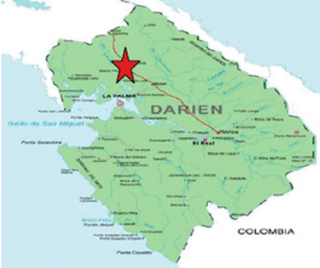Zimba, Panama
![]()
![]()
![]()
![]()
![]()
![]()
![]() Click on Programs to learn more about their work in this community
Click on Programs to learn more about their work in this community
General Information

| Population* | 350 |
| Number of homes | 65 |
| Avg # of people per home | 5 |
| Electricity | None |
| Corregimiento | Santa Fe |
| District | Chepigana |
| Corresponding Health Center | Centro de Salud – Santa Fe |
| Distance from compounds | 1.5 hours from Meteti |
| Road conditions | Good |
* Population does not reflect how many patients will be seen on medical
brigades as many people from surrounding communities come seeking
Medical Brigades medical attention.
Expressed Needs and Capacities
The top three areas of expressed needs are clean water, access to health centers, and electricity.
Zimba's educational system includes a primary school (K-6) with three teachers. The school is located in the center of the village and is comprised of two classrooms, a kitchen and lunchroom, a small library, and a recreation area outside. The closest secondary school can be found in Meteti, which is roughly a 20 minute bus ride away. The closest high school (grades 10-12) is located in Torti/Zapallal, which is roughly an hour bus ride away.
Zimba has a gravity-run aqueduct water system. The source of the water is located 4 kilometers away and almost 100% of the population receives water from this aqueduct. Despite the accessibility, the pipes are nearly 20 years old and any water that comes from the aqueduct is contaminated and not potable; however, most families boil, chlorinate, or filter it before drinking. Currently, the community has a Water Committee with eight members who meet occasionally.
Zimba does not have a Centro de Salud (health center) and the closest center is in Sante Fe. There are no health care assistants or midwifes in the village, but they do have a Health Committee. For dental access, people can travel to the community of Santa Fe as well. Occasionally, medical and dental clinics have been given to the community by MINSA (Ministry of Health), but the last one took place over a year ago. The most common illnesses seen by community members are parasites, muscular problems, and the common cold. Most households do not have functional sanitation facilities and only 15 have water filters. Nearly 100% of households have gas stoves but only 25% have cement floors.
The houses in Zimba are very traditional and constructed high off the ground from wood with zinc or penca (palm tree leaf) roofing. Over 50% of members in the community partake in agriculture for consumption and to earn a living. They most commonly cultivate beans and corn on their privately-owned pieces of land.
Local businesses in the community consist of a cantina and a couple small stores that sell staple dry goods and household items. There is a lack of support for these businesses, as the closest bank is in Meteti or Torti and there is no active cooperative in the community. This means in order for businesses or community members to open a savings account or access loans outside of from family or friends, they must spend money to travel to another community.
In this particular region of Panama, no recycling or trash collection system has been established to aid community members in waste management. Zimba has not reported any locally based initiatives to reduce or reuse waste, and community members burn or bury their trash as the main form of disposal. There has been no form of environmental education programs within Zimba and there is no environmental committee in the community.
While there are no lawyers in Zimba, there is access to legal support in Santa Fe. More specifically, while many rural Panamanians do not have proof of owenership of their land, 75-100% of Zimba community members have titles to their property.
The community follows the general administrative government structure of Panama.
There are two other ogranizations that work in Zimba. Peace Corp created a park for youth and Pro Niños helped create an ongoing school lunch program which includes supporting an organic garden and raising chickens.
During the internship in the summer of 2013, a Mental/Dental clinic was held and more will be held this upcoming brigade season.
Source of Information: Key Informant Interview
Date of Interview: November 29, 2013
Last Visited: February 11, 2014
Last Updated: February 28, 2014